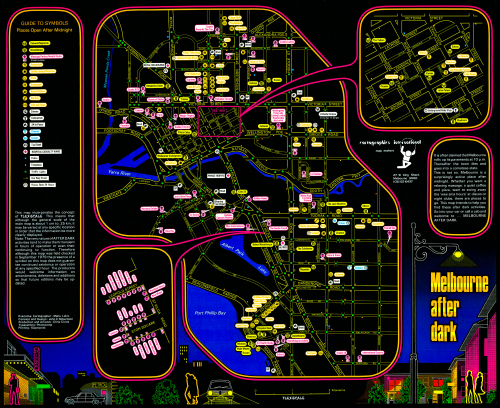 Back to the use of maps as a framework for artistic expression with Richter’s Townscapes. Here, artist Richter has created a range of paintings that are based on oblique views of different towns and cities. He approaches each work from a different perspective and experiments with scale that mimics the approach a cartographer takes in determining how much to generalize a feature.
Back to the use of maps as a framework for artistic expression with Richter’s Townscapes. Here, artist Richter has created a range of paintings that are based on oblique views of different towns and cities. He approaches each work from a different perspective and experiments with scale that mimics the approach a cartographer takes in determining how much to generalize a feature.
 For some paintings, the scale is smaller and the view is from a higher elevation and so the buildings take on a rather abstract form, perhaps just the general shape and the inclusion of major features. Examples that are at a larger scale inevitably include more of the building’s detail. That said, the large scale paintings are perhaps less easy to recognise due to the larger size of shapes. Because the paintings are all in shades of grey we tend to see large indistinct blocks of grey which are not necessarily immediately seen as buildings. Of course, standing back from the paintings gives us a different perspective, the image occupies a smaller form and we tend to see the images more clearly. At distance they begin to look like monochrome oblique aerial photographs.
For some paintings, the scale is smaller and the view is from a higher elevation and so the buildings take on a rather abstract form, perhaps just the general shape and the inclusion of major features. Examples that are at a larger scale inevitably include more of the building’s detail. That said, the large scale paintings are perhaps less easy to recognise due to the larger size of shapes. Because the paintings are all in shades of grey we tend to see large indistinct blocks of grey which are not necessarily immediately seen as buildings. Of course, standing back from the paintings gives us a different perspective, the image occupies a smaller form and we tend to see the images more clearly. At distance they begin to look like monochrome oblique aerial photographs.
 Richter also experiments with different brushstrokes and textures, going from very fluid approaches to strongly geometric. As a collection, they give us a fascinating way to reflect on the urban form and, perhaps, show us a little of the artistry in how we approach the task of generalization as part of cartographic design. Scale, form, texture and viewing distance all strongly modify the viewing experience. These are key processes in understanding cartographic design.
Richter also experiments with different brushstrokes and textures, going from very fluid approaches to strongly geometric. As a collection, they give us a fascinating way to reflect on the urban form and, perhaps, show us a little of the artistry in how we approach the task of generalization as part of cartographic design. Scale, form, texture and viewing distance all strongly modify the viewing experience. These are key processes in understanding cartographic design.
You can view more of Richter’s Townscapes at his web site here.








